Related Research Articles

An electric light, lamp, or light bulb is an electrical component that produces light. It is the most common form of artificial lighting. Lamps usually have a base made of ceramic, metal, glass, or plastic, which secures the lamp in the socket of a light fixture, which is often called a "lamp" as well. The electrical connection to the socket may be made with a screw-thread base, two metal pins, two metal caps or a bayonet mount.

David Baltimore is an American biologist, university administrator, and 1975 Nobel laureate in Physiology or Medicine. He is a professor of biology at the California Institute of Technology (Caltech), where he served as president from 1997 to 2006. He founded the Whitehead Institute and directed it from 1982 to 1990. In 2008, he served as president of the American Association for the Advancement of Science in 2008.
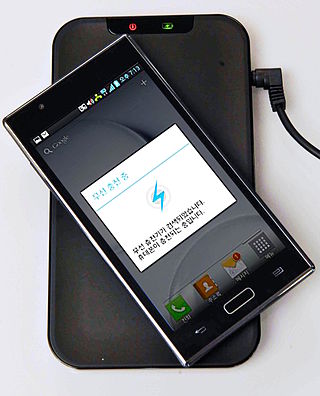
Wireless power transfer (WPT), wireless power transmission, wireless energy transmission (WET), or electromagnetic power transfer is the transmission of electrical energy without wires as a physical link. In a wireless power transmission system, an electrically powered transmitter device generates a time-varying electromagnetic field that transmits power across space to a receiver device; the receiver device extracts power from the field and supplies it to an electrical load. The technology of wireless power transmission can eliminate the use of the wires and batteries, thereby increasing the mobility, convenience, and safety of an electronic device for all users. Wireless power transfer is useful to power electrical devices where interconnecting wires are inconvenient, hazardous, or are not possible.
AIDS-related lymphoma describes lymphomas occurring in patients with acquired immunodeficiency syndrome (AIDS).
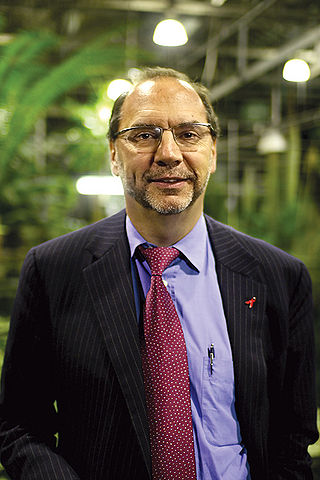
Sir Peter Karel, Baron Piot, is a Belgian-British microbiologist known for his research into Ebola and AIDS.

Luc Montagnier was a French virologist and joint recipient, with Françoise Barré-Sinoussi and Harald zur Hausen, of the 2008 Nobel Prize in Physiology or Medicine for his discovery of the human immunodeficiency virus (HIV). He worked as a researcher at the Pasteur Institute in Paris and as a full-time professor at Shanghai Jiao Tong University in China.

In the history of calculus, the calculus controversy was an argument between the mathematicians Isaac Newton and Gottfried Wilhelm Leibniz over who had first invented calculus. The question was a major intellectual controversy, which began simmering in 1699 and broke out in full force in 1711. Leibniz had published his work first, but Newton's supporters accused Leibniz of plagiarizing Newton's unpublished ideas. Leibniz died in 1716, shortly after the Royal Society, of which Newton was a member, found in Newton's favor. The modern consensus is that the two men developed their ideas independently.
Sonagachi is a neighbourhood in Kolkata, India, located in North Kolkata near the intersection of Jatindra Mohan Avenue with Beadon Street and Sovabazar, about one kilometer north of the Marble Palace area. Sonagachi is among the largest red-light districts in Asia and the world with several hundred multi-storey brothels residing more than 16,000 commercial sex workers.
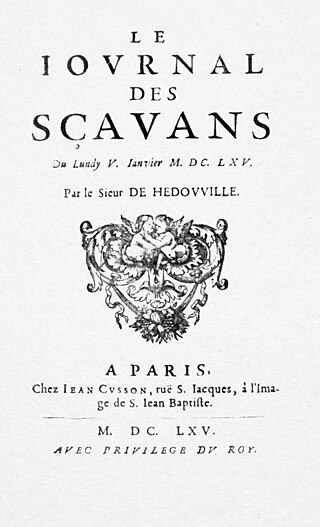
The Journal des sçavans, established by Denis de Sallo, is the earliest academic journal published in Europe. It is thought to be the earliest published scientific journal. It currently focuses on European history and premodern literature.
In science, priority is the credit given to the individual or group of individuals who first made the discovery or propose the theory. Fame and honours usually go to the first person or group to publish a new finding, even if several researchers arrived at the same conclusion independently and at the same time. Thus, between two or more independent discoverers, the first to publish is the legitimate winner. Hence, the tradition is often referred to as the priority rule, the procedure of which is nicely summed up in a phrase "publish or perish", because there are no second prizes. In a way, the race to be first inspires risk-taking that can lead to scientific breakthroughs which is beneficial to the society. On the other hand, it can create unhealthy competition and incentives to publish low-quality findings, which can lead to an unreliable published literature and harm scientific progress.
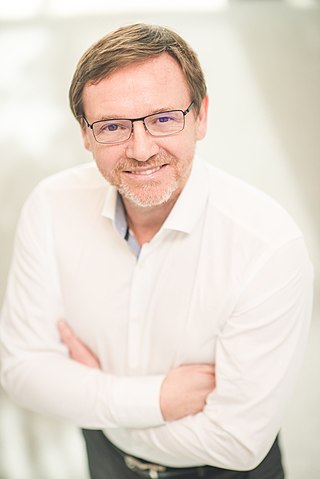
Rudi Pauwels is a Belgian pharmacologist and biotech entrepreneur.

Marin Soljačić is a Croatian-American physicist and electrical engineer known for wireless non-radiative energy transfer.
An ultrashort pulse laser is a laser that emits ultrashort pulses of light, generally of the order of femtoseconds to one picosecond. They are also known as ultrafast lasers owing to the speed at which pulses "turn on" and "off"—not to be confused with the speed at which light propagates, which is determined by the properties of the medium, particularly its index of refraction, and can vary as a function of field intensity and wavelength.

Robert Charles Gallo is an American biomedical researcher. He is best known for his role in establishing the human immunodeficiency virus (HIV) as the infectious agent responsible for acquired immune deficiency syndrome (AIDS) and in the development of the HIV blood test, and he has been a major contributor to subsequent HIV research.
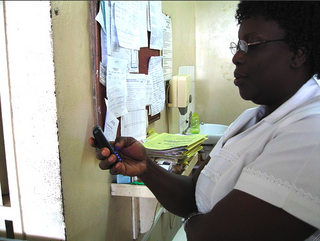
mHealth is an abbreviation for mobile health, a term used for the practice of medicine and public health supported by mobile devices. The term is most commonly used in reference to using mobile communication devices, such as mobile phones, tablet computers and personal digital assistants (PDAs), and wearable devices such as smart watches, for health services, information, and data collection. The mHealth field has emerged as a sub-segment of eHealth, the use of information and communication technology (ICT), such as computers, mobile phones, communications satellite, patient monitors, etc., for health services and information. mHealth applications include the use of mobile devices in collecting community and clinical health data, delivery/sharing of healthcare information for practitioners, researchers and patients, real-time monitoring of patient vital signs, the direct provision of care as well as training and collaboration of health workers.

HIV/AIDS research includes all medical research that attempts to prevent, treat, or cure HIV/AIDS, as well as fundamental research about the nature of HIV as an infectious agent and AIDS as the disease caused by HIV.

Dmitri Leonidovich Romanowsky was a Russian physician who is best known for his invention of an eponymous histological stain called Romanowsky stain. It paved the way for the discovery and diagnosis of microscopic pathogens, such as malarial parasites, and later developments of new histological stains that became fundamental to microbiology and physiology.
The Cameron Prize for Therapeutics of the University of Edinburgh is awarded by the College of Medicine and Veterinary Medicine to a person who has made any highly important and valuable addition to Practical Therapeutics in the previous five years. The prize, which may be awarded biennially, was founded in 1878 by Andrew Robertson Cameron of Richmond, New South Wales, with a sum of £2,000. The University's senatus academicus may require the prizewinner to deliver one or more lectures or to publish an account on the addition made to Practical Therapeutics. A list of recipients of the prize dates back to 1879.

Sir Patrick John Thompson Vallance is a British physician, scientist, and clinical pharmacologist who has worked in both academia and industry. He served as the Chief Scientific Adviser to the Government of the United Kingdom from 2018 to 2023. On stepping down, he became chair of the Natural History Museum in London.

Nikola Tesla patented the Tesla coil circuit on April 25, 1891. and first publicly demonstrated it May 20, 1891 in his lecture "Experiments with Alternate Currents of Very High Frequency and Their Application to Methods of Artificial Illumination" before the American Institute of Electrical Engineers at Columbia College, New York. Although Tesla patented many similar circuits during this period, this was the first that contained all the elements of the Tesla coil: high voltage primary transformer, capacitor, spark gap, and air core "oscillation transformer".
References
- ↑ Richeson, David S. (2022-06-30). "The Sordid Past of the Cubic Formula". Quanta Magazine. Retrieved 2023-10-11.
- ↑ Joel Spencer, Ronald Graham, The Elementary Proof of the Prime Number Theorem, THE MATHEMATICAL INTELLIGENCER
- ↑ Rekvenyi, Kamilla (2019-05-04). "Paul Erdős's mathematics as a social activity". British Journal for the History of Mathematics. 34 (2): 134–142. doi:10.1080/26375451.2019.1593036. ISSN 2637-5451.
- ↑ Coopersmith, Jennifer (May 2015). Energy, the Subtle Concept: The discovery of Feynman's blocks from Leibniz to Einstein. Oxford University Press. pp. 240–257. ISBN 9780198716747.
- ↑ O'Connor, J.J.; Robertson, E. F. (1998). "Samuel König - Biography". MacTutor. Retrieved 2023-11-12.
- ↑ Hong, Sungook (October 1994). "Marconi and the Maxwellians: The Origins of Wireless Telegraphy Revisited". Technology and Culture. 35 (4): 717–749. doi:10.2307/3106504. JSTOR 3106504. S2CID 112949474 – via JSTOR.
- ↑ Virginia Trimble, "Chandrasekhar and the history of astronomy", Fluid Flows to Black Holes, pp. 49-53 (2011)
- ↑ Gell-Mann, M. (15 March 1961). "The Eightfold Way: A theory of strong interaction symmetry". Synchrotron Laboratory. Office of Scientific and Technical Information Technical Report. Pasadena, CA: California Institute of Technology. doi:10.2172/4008239. TID-12608; CTSL-20.
- ↑ Ne'eman, Y. (August 1961). "Derivation of strong interactions from a gauge invariance". Nuclear Physics . Amsterdam: North-Holland Publishing Co. 26 (2): 222–229. Bibcode:1961NucPh..26..222N. doi:10.1016/0029-5582(61)90134-1.
- ↑ Crease, Robert P. (2010). "Priority battles". Physics World. Retrieved 2023-10-18.
- ↑ Carlowicz, Michael J.; López, Ramón (2002). Storms from the Sun: The Emerging Science of Space Weather. Joseph Henry Press. pp. 1–382. ISBN 978-0309076425 . Retrieved 19 June 2020.
- ↑ Serrano, Juan D. (2013-02-01). "Trying Ursus: A Reappraisal of the Tycho-Ursus Priority Dispute". Journal for the History of Astronomy. 44 (1): 17–46. Bibcode:2013JHA....44...17A. doi:10.1177/002182861304400102. S2CID 118331268 – via Sage Publishing.
- ↑ Pasachoff, Jay M. (2015). "Simon Marius's Mundus Iovialis: 400th Anniversary in Galileo's Shadow". Journal for the History of Astronomy. 46 (2): 218–234. Bibcode:2015AAS...22521505P. doi:10.1177/0021828615585493. S2CID 120470649.
- ↑ Matthews, Robert. "Who really discovered oxygen?". BBC Science Focus. Retrieved 2023-10-11.
- ↑ van Spronsen, Johannes W. (March 1969). "The priority conflict between Mendeleev and Meyer". Journal of Chemical Education. 46 (3): 136. Bibcode:1969JChEd..46..136V. doi:10.1021/ed046p136. ISSN 0021-9584.
- ↑ Burdett, Carolyn (2014-05-15). "Darwin and the theory of evolution". British Library. Retrieved 2023-10-11.
- ↑ Weale, Michael E. (August 2015). "Patrick Matthew's law of natural selection: Matthew's Law of Natural Selection". Biological Journal of the Linnean Society. 115 (4): 785–791. doi: 10.1111/bij.12524 .
- ↑ Cozzens, Susan E. (1989). Social control and multiple discovery science: the opiate receptor case. Suny series in science, technology and society. Albany, N.Y: State Univ. of New York Pr. ISBN 978-0-88706-935-2.
- ↑ Forsdyke, Donald R.; Mortimer, James R. (May 2000). "Chargaff's Legacy". Gene. 261 (1): 127–137. doi:10.1016/s0378-1119(00)00472-8. PMID 11164044 . Retrieved 2023-10-19.
- ↑ Lamm, Ehud; Harman, Oren; Veigl, Sophie Juliane (2020-06-01). "Before Watson and Crick in 1953 Came Friedrich Miescher in 1869". Genetics. 215 (2): 291–296. doi:10.1534/genetics.120.303195. ISSN 1943-2631. PMC 7268995 . PMID 32487691.
- ↑ Beckett, Chris (2004-04-01). "For the Record: The Francis Crick Archive at the Wellcome Library". Medical History. 48 (2): 245–260. doi:10.1017/S0025727300007419. ISSN 2048-8343. PMC 546341 . PMID 15151106.
- ↑ Ambrose, Charles T. (January 2007). "The priority dispute over the function of the lymphatic system and Glisson's ghost (the 18th-century Hunter–Monro Feud)". Cellular Immunology. 245 (1): 7–15. doi:10.1016/j.cellimm.2007.02.015. PMID 17451660.
- ↑ Ambrose, Charles T. (July 2006). "Immunology's first priority dispute—An account of the 17th-century Rudbeck–Bartholin feud". Cellular Immunology. 242 (1): 1–8. doi:10.1016/j.cellimm.2006.09.004. PMID 17083923.
- ↑ Natale, Gianfranco; Bocci, Guido; Ribatti, Domenico (2017-06-14). "Scholars and scientists in the history of the lymphatic system". Journal of Anatomy. 231 (3): 417–429. doi:10.1111/joa.12644. ISSN 0021-8782. PMC 5554832 . PMID 28614587.
- ↑ Hall, A Rupert; Hall, Marie Boas (October 1980). "The first human blood transfusion: priority disputes (Henry Oldenburg)". Medical History. 24 (4): 461–465. doi:10.1017/S0025727300040588. ISSN 0025-7273. PMC 1082682 . PMID 6999258.
- ↑ Chaudhury, Abhijit (2021). "The forgotten malariologist: Giovanni Battista Grassi (1854–1925)". Tropical Parasitology. 11 (1): 16–18. doi: 10.4103/tp.tp_21_21 . ISSN 2229-5070. PMC 8213122 . PMID 34195055.
- ↑ Cox, Francis EG (2010-02-01). "History of the discovery of the malaria parasites and their vectors". Parasites & Vectors. 3 (1): 5. doi: 10.1186/1756-3305-3-5 . ISSN 1756-3305. PMC 2825508 . PMID 20205846.
- ↑ Capanna, Ernesto (March 2006). "Grassi versus Ross: who solved the riddle of malaria?". International Microbiology. 9 (1): 69–74. ISSN 1139-6709. PMID 16636993.
- ↑ Prasad, Amit (2007). "The (Amorphous) Anatomy of an Invention: The Case of Magnetic Resonance Imaging (MRI)". Social Studies of Science. 37 (4): 533–560. doi:10.1177/0306312706075334. ISSN 0306-3127. JSTOR 25474534. PMID 18175616. S2CID 24784055.
- ↑ Rawling, Alison (1994). "The AIDS Virus Dispute: Awarding Priority for the Discovery of the Human Immunodeficiency Virus (HIV)". Science, Technology, & Human Values. 19 (3): 342–360. doi:10.1177/016224399401900305. ISSN 0162-2439. JSTOR 690029. S2CID 144769393.
- ↑ Rawling, Alison (1990-09-22). "Forum: Montagnier, Gallo or both? - On who the scientific community believes discovered HIV". New Scientist. Retrieved 2023-10-19.
- ↑ Rawling, Alison (July 1994). "The AIDS Virus Dispute: Awarding Priority for the Discovery of the Human Immunodeficiency Virus (HIV". Science, Technology, & Human Values. 19 (3): 342–360. doi:10.1177/016224399401900305. ISSN 0162-2439. S2CID 144769393.
- ↑ Markel, Howard (2020-03-24). "How the discovery of HIV led to a transatlantic research war". PBS NewsHour. Retrieved 2023-10-19.
- ↑ Bazell, Robert (2008-10-06). "Dispute behind Nobel Prize for HIV research". NBC News. Retrieved 2023-10-19.
- ↑ Aubrey, John; Bennett, Kate (2015). Brief lives: with "An apparatus for the lives of our English mathematical writers". Oxford: Oxford University Press. ISBN 978-0-19-968953-8.
- ↑ Jonathan Rée, I See a Voice (1999), pp. 107–8.
- ↑ Elliott, Jane (26 July 2008). "Find could end 350-year science dispute". BBC News . Retrieved 2008-10-19.
- ↑ A. R. Hall, "Horology and criticism: Robert Hooke", Studia Copernicana, XVI, Ossolineum, 1978, 261–81.
- ↑ Gould, Rupert T. (1923). The Marine Chronometer. Its History and Development. London: J. D. Potter. pp. 158–171. ISBN 0-907462-05-7.
- ↑ Burton, Tara Isabella (2023-06-27). "How Thomas Edison Tricked the Press Into Believing He'd Invented the Light Bulb". Smithsonian Magazine. Retrieved 2023-10-19.
- ↑ Peterson, Elizabeth; McKelvie, Callum (2022-11-02). "Who Invented the Light Bulb?". Live Science . Retrieved 2023-10-19.
- ↑ Ganapati, Priya (2009-12-18). "Dec. 18, 1878: Let There Be Light — Electric Light". Wired. ISSN 1059-1028 . Retrieved 2023-10-19.
- ↑ Spear, Brian (2013-03-01). "Let there be light! Sir Joseph Swan and the incandescent light bulb". World Patent Information. 35 (1): 38–41. doi:10.1016/j.wpi.2012.10.001. ISSN 0172-2190.
- ↑ "Wireless Telegraphy". Modern Engineering Practice. Vol. VII. American School of Correspondence. 1903. p. 10.
- ↑ Geddes (1920) "The Response of Plants to Wireless Stimulation" (chapter 13), pp. 172–80
- ↑ Fessenden, Reginald (1908) "Wireless Telephony", Transactions of the American Institute of Electrical Engineers (volume 27, part 1), June 29, 1908, pp. 553–630
- ↑ Bondyopadhyay, Prebir K. (1995) "Guglielmo Marconi – The father of long distance radio communication – An engineer's tribute", 25th European Microwave Conference: Volume 2, pp. 879–85
- ↑ United States Patent Office Correspondence (1901-1902) (landelldemoura.com.br))
- ↑ Borisova, Nina (2019). "Отечественные разногласия о приоритете А.С. Попова в изобретении радио". Terra Linguistica (in Russian). 36 (2): 98–111. doi:10.18721/JHSS.10209.
- ↑ Tesla, N., & Anderson, L. I. (1998). Nikola Tesla: Guided Weapons & Computer Technology. Tesla presents series, pt. 3. Breckenridge, Colo: Twenty-First Century Books.
- ↑ Tesla, N., & Anderson, L. I. (2002). Nikola Tesla on his work with alternating currents and their application to wireless telegraphy, telephony, and transmission of power: an extended interview. Tesla presents series, pt. 1. Breckenridge, Colo: Twenty-First Century Books.
- ↑ Postman, Neil (1999-03-29). "Electrical Engineer PHILO FARNSWORTH". Time . ISSN 0040-781X . Retrieved 2023-10-19.
- ↑ Ganesan, Rajita (2015-01-15). "The aviator?". Business Standard . Retrieved 2023-10-19.
- ↑ Deb, Siddhartha (2015-05-14). "Those Mythological Men and Their Sacred, Supersonic Flying Temples". The New Republic . Retrieved 2023-10-19.
- 1 2 Wragg, David W. (1974). Flight Before Flying. Frederick Fell Publishers, Inc.
- ↑ Weissenborn, G.K.; "Did Whitehead fly?", Air Enthusiast35, Pilot Press (1988), Pages 19-21 and 74-75.
- ↑ Schlenoff, Daniel C. "Scientific American Debunks Claim Gustave Whitehead Was "First in Flight"". Scientific American. Retrieved 2023-10-19.
- 1 2 Magazine, Smithsonian; Crouch, Tom. "Yes, the Wright Brothers Really Were the First to Fly". Smithsonian Magazine. Retrieved 2023-10-19.
- ↑ "Richard Pearse First Flyer" Archived 2014-10-17 at the Wayback Machine NZEdge.com. Retrieved Oct. 13, 2014
- ↑ "Fact Sheet Richard Pearse" Museum of Transport and Technology (MOTAT). Retrieved Oct. 13, 2014
- ↑ "Karl Jatho". FlyingMachines.org. Carroll Gray. Archived from the original on June 30, 2009. Retrieved November 22, 2021.
- ↑ "Pigs Might Fly: The Gliders & Hoppers". Early Aviation Pioneers. Retrieved October 16, 2014.
- ↑ "First powered flight in the history of aviation". The Karl-Jatho-Project. Retrieved October 16, 2014.
- ↑ "Primeiro avião do mundo", Rank Brasil: 0, 20 July 2012
- ↑ Chavanne, Bettina H. (November 2006). "In the Museum". Smithsonian Magazine. Retrieved 2023-10-19.